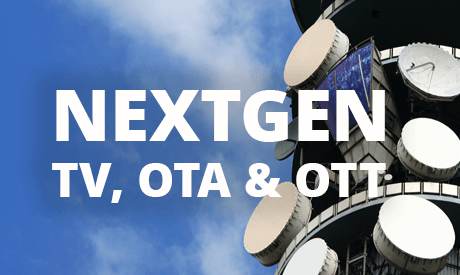
If you are a broadcaster, it’s likely you know about ATSC 3.0, aka NextGen TV. By the end of the year, at least 70 U.S. television markets are due to be transmitting 3.0 to viewers.
(For those who don’t know, ATSC stands for the Advanced Television Systems Committee, the organization of CE manufacturers, broadcasters and technology vendors and experts that created the 3.0 standard.)
Viewers with NextGen TVs will be able to receive 3.0 signals over the air. At this point NextGen TV sets are available from LG Electronics, Samsung, Sony and Hisense.
One of the great things about this new digital television (DTV) standard is that unlike the existing DTV standard used in the United States and elsewhere, over-the-air (OTA) reception is much, much more likely assured than transmission of what has come to be called ATSC 1.0 signals.
Without getting too “techie,” it is sufficient to say that ATSC 3.0 uses the same modulation technique that wireless carriers rely upon to transmit data to smartphones and devices (although at the moment those devices cannot receive NextGen TV, which is another story for another time).
What that means for TV broadcasters from a technical point of view is that one of the fundamental technologies upon which ATSC 3.0 is built has a proven track record of delivering a robust OTA signal. It’s a track record that’s confirmed every time you watch Netflix programming or a YouTube video on your smartphone.
But there’s a whole lot more to NextGen TV—from both a technology and a business point of view—that promises to “Make Television Great Again,” as one of the vendors at the core of the technology needed to put 3.0 on the air said a few years back.
NextGen TV Is IP-Based
Another thing NextGen TV has going for it is that ATSC 3.0 is based upon the transmission of IP packets, not MPEG-2 Transport Stream (TS). Believe it or not, there was a time when broadcasters were at the leading (bleeding?) edge of digital video technology—years ago when they and studios pressing movies and other content onto DVDs relied on MPEG-2 to distribute digital video content. That was long before anyone ever thought about the internet as a delivery mechanism for video, much less using an IP (internet protocol) packet to carry the data needed to convey digital video and audio.
Unfortunately for broadcasters, due to regulatory obligations, the technology at the heart of DTV content transport was left in the dust by successive generations of video compression and the packetization of data into a format that in the intervening years became ubiquitous. As a result, broadcasters were sort of marooned on TS Island as the digital cruise ship sailed on by and carried competitors across the horizon.
ATSC 3.0 changes all of that. It’s IP-based, meaning that the content a broadcaster transmits is compatible with the rest of the world at a core level. What’s more, because it moves IP packets from a broadcaster to viewers it is also compatible with the internet. That means broadcast content can stream via the internet to NextGen TV sets just as Netflix, Hulu or Amazon Prime move content to smart TVs and streaming devices like a Roku set-top box or Amazon Fire TV Stick.
Right Tech, Right Now
NextGen TV comes for broadcasters right as Connected TVs (CTVs), over-the-top (OTT) service and Free Ad-Supported Streaming Television (FAST) channels are leaving their mark on the distribution of movies, TV shows and the bread and butter of many local TV stations: news, sports and weather.
Thanks to ATSC 3.0, broadcasters are no longer stuck on TS Island. Rather, with NextGen TV they have a speedboat to catchup to that horizon-bound cruise ship of digital content and compete for viewer eyeballs and—most importantly—the ad dollars associated with those eyeballs.
NextGen TV is the next logical step for broadcasters, and nothing about it prevents them from taking advantage of all of the platforms already associated with FAST channel distribution and OTT streaming. In fact, NextGen TV is both OTA and OTT at the same time, which opens up a number of interesting possibilities for broadcasters that are too numerous to explore in this limited space.
Of course, there are many business and marketing hurdles to overcome before broadcasters fully realize the potential of NextGen TV, but at least ATSC 3.0 delivers a sound foundation for local television stations to stay in the game.
Staying In The Game
Legendary Green Bay Packers coach Vince Lombardi is quoted as saying: “The only place that ‘success’ comes before ‘work’ is in the dictionary.”
Nothing could be truer of where television broadcasters are at the moment with their rollout of ATSC 3.0. They’re doing the hard work necessary to succeed. Most of that work to date has focused on a few fronts: developing a digital standard that can stand up to the test of time—one that can compete with other digital media—and deploying ATSC 3.0 over-the-air service in an environment that can best be described as restrictive.
(Unlike the analog-to-digital TV conversion, broadcasters are making the transition to 3.0 on a voluntary basis without the benefit of additional channel assignments on which to simulcast until viewers complete their own transition to NextGen TV.)
However, there can be no question about the dedication of television broadcasters in doing and continuing to do the hard work necessary to succeed with ATSC 3.0.
In a few years, having gone through the effort, the expense, the defeats and the victories associated with bringing NextGen TV to viewers, broadcasters will look back on this period as the time in their history when they laid the foundation for their future. Over the next few weeks, I’ll be looking at some of the opportunities and challenges they are facing and the technology we have developed that will help them to compete with other digital media and boost their bottom lines.